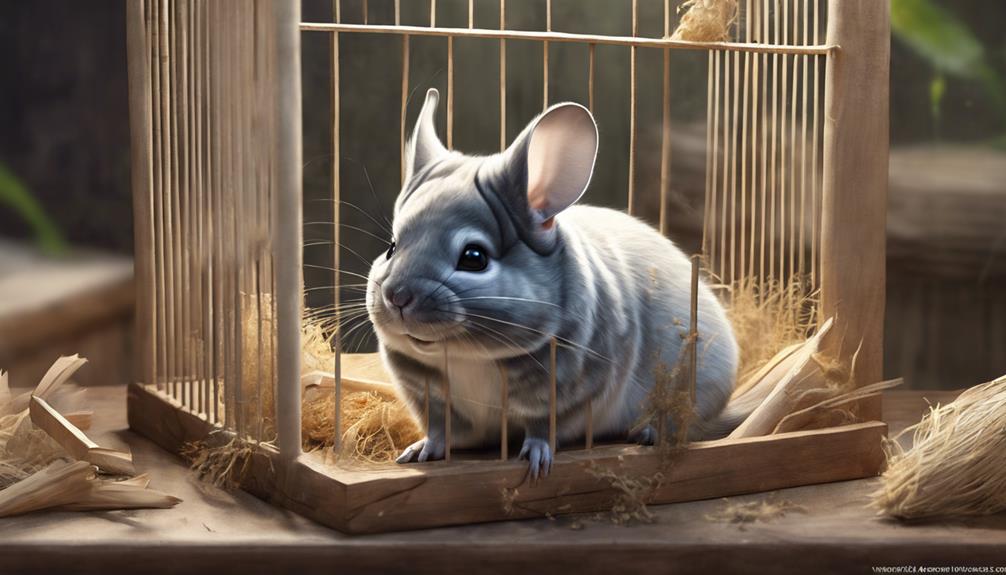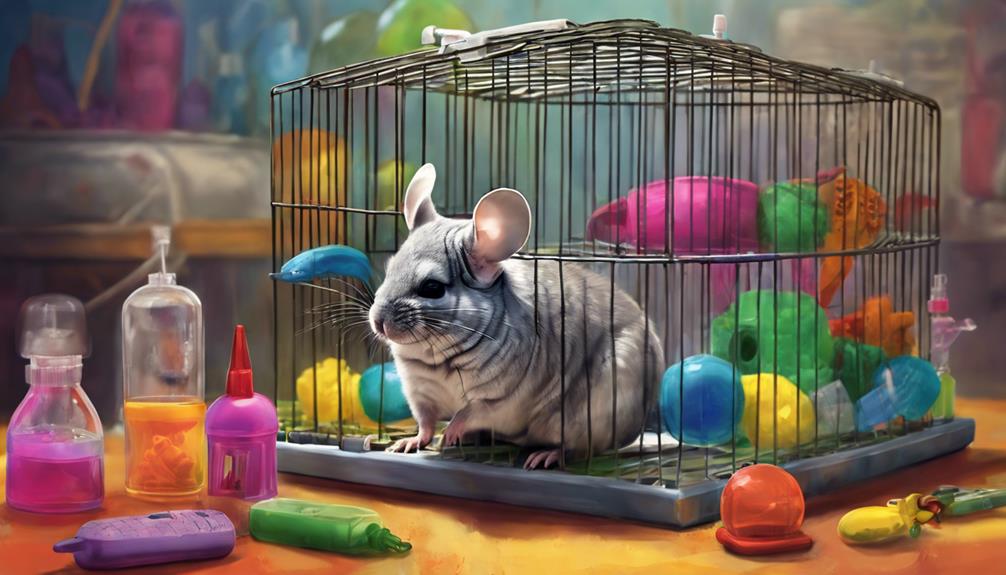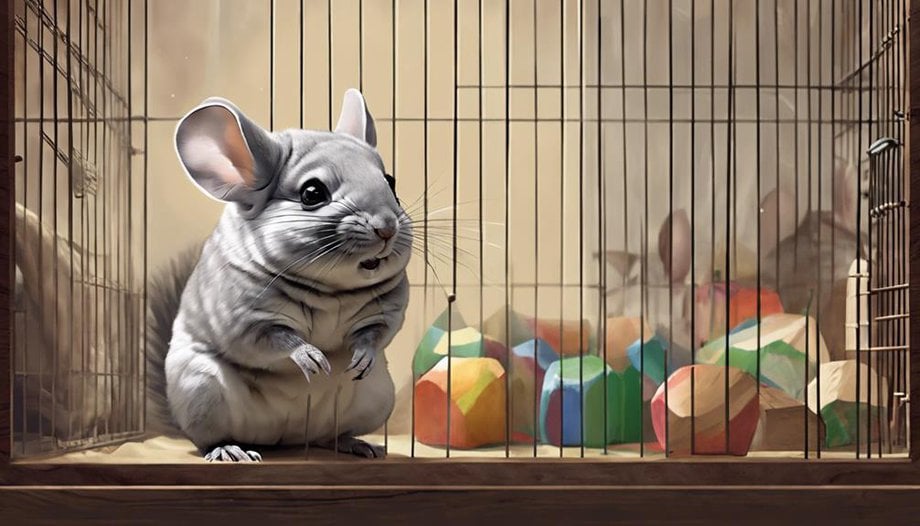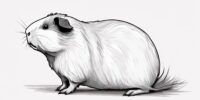Why It's Important to Avoid Plastic in Chinchilla Cages

Plastic is a common material used in chinchilla cages due to its affordability and durability. However, there are hidden dangers associated with plastic that can impact your pet's digestive health. Chinchillas are known to chew on their cage accessories, including plastic components, which can lead to ingestion. When plastic is ingested, it can cause gastrointestinal blockages or impactions, which are serious medical conditions that require immediate veterinary attention.
To protect your chinchilla's digestive health, it is important to carefully inspect their cage for any plastic parts that show signs of chewing or damage. Replace these parts with chinchilla-safe alternatives made of wood, metal, or other non-toxic materials. Providing your chinchilla with plenty of chew toys and safe items to gnaw on can also help redirect their chewing behavior away from plastic components. By being proactive and vigilant about the materials in your chinchilla's cage, you can help prevent digestive issues and keep your pet healthy and happy.
Key Takeaways
- Plastic in chinchilla cages can lead to serious health risks like gastrointestinal blockages.
- Certain plastics may leach harmful chemicals impacting respiratory and skin health.
- Opt for safe, natural chew toys like wooden or hay-based items to prevent ingestion risks.
- Prioritize safe bedding materials like kiln-dried pine or fleece over plastic for comfort and health.
Health Risks of Plastic in Chinchilla Cages
Plastic poses significant health risks to chinchillas when used in their cages, compromising their well-being and longevity. The issue lies in plastic toxicity, as certain plastics can leach harmful chemicals that may harm these delicate creatures.
Ensuring material safety is paramount in safeguarding the health of chinchillas. When exposed to toxic plastics, chinchillas may experience a range of adverse effects, from respiratory issues to skin irritations, and even more severe conditions in the long term.
By eliminating plastic from their living spaces, chinchilla owners can provide a safer environment for their pets, promoting a healthier and more fulfilling life for these furry companions. Prioritizing the removal of plastic from chinchilla cages is a proactive step towards ensuring their well-being and reducing the risks associated with harmful materials.
It's essential to choose cage materials carefully, opting for safer alternatives to protect the health and longevity of these beloved pets.
Chewing Hazards for Chinchillas
Chinchillas love to chew, but certain plastic chew toys can pose serious health risks to these furry critters. Understanding the potential dangers of plastic materials in their cages is important for chinchilla owners.
Plastic Chew Toys
When selecting toys for your chinchilla's cage, prioritize safety over aesthetics to prevent potential chewing hazards. Opt for natural alternatives and non-toxic options to provide a safe environment for your furry friend.
Here are some key points to bear in mind when selecting chew toys:
- Wooden Toys: Chinchillas love to gnaw on wood, so wooden toys are a safe and enjoyable option.
- Seagrass or Willow Balls: These natural materials are great for promoting safe chewing and healthy play.
- Mineral Chews: Providing mineral chews can help keep your chinchilla's teeth healthy and prevent overgrowth.
Health Risks
To safeguard your chinchilla's well-being, it is important to be mindful of potential health risks posed by chewing hazards in their environment. Chinchillas have a natural inclination to chew on objects to keep their teeth healthy and worn down. However, certain materials can pose toxicity concerns if ingested, leading to serious health issues. When choosing items for your chinchilla's cage, prioritize material safety to prevent accidental ingestion of harmful substances. Plastic, in particular, can be dangerous as it may contain chemicals that are toxic to chinchillas. Opt for safe alternatives like wooden toys or hay-based items to guarantee your furry friend's well-being. Check out the table below for a quick comparison of safe vs. unsafe cage materials.
| Safe Materials | Unsafe Materials |
|---|---|
| Wood | Plastic |
| Hay-based items | Rubber |
| Natural fibers | Styrofoam |
Chemical Exposure Concerns

Concerns regarding exposure to chemicals in chinchilla cages must be addressed to guarantee the well-being of these small pets. Chinchillas are sensitive creatures, and any risk assessment should include the toxicity levels of materials used in their environment.
Here are some key points to think about:
- Plasticizers: Chemicals found in plastic, such as phthalates, can leach out and be harmful when inhaled or ingested by chinchillas.
- VOCs: Volatile Organic Compounds present in some plastics can evaporate into the air, potentially causing respiratory issues for chinchillas.
- BPA: Bisphenol A, commonly found in plastics, is a known endocrine disruptor that can lead to hormonal imbalances in chinchillas.
Given these risks, it's important to opt for chinchilla cages made from safe, non-toxic materials like metal or wood. Prioritizing the removal of plastics from their environment can greatly reduce the chances of chemical exposure and promote the health and freedom of these delightful pets.
Digestive Issues From Ingesting Plastic
Ingesting plastic poses a severe risk of digestive issues for chinchillas due to their delicate gastrointestinal systems. Chinchillas are prone to digestive discomfort when exposed to plastic ingestion, as their bodies struggle to break down foreign materials, leading to potential blockages or irritations in their digestive tracts. The consumption of plastic can disrupt their natural digestive processes, causing pain, discomfort, and even serious health complications. To highlight the dangers of plastic ingestion for chinchillas, consider the following table:
| Effects of Plastic Ingestion on Chinchillas |
|---|
| Digestive Discomfort |
| Blockages in Gastrointestinal Tract |
| Irritation and Inflammation |
| Potential Health Complications |
This table illustrates the repercussions of plastic ingestion, emphasizing the importance of using safe, non-toxic materials in chinchilla cages. By prioritizing their well-being and opting for plastic-free environments, chinchilla owners can promote digestive health and overall well-being in these charming creatures.
Importance of Non-Toxic Materials

Incorporating non-toxic materials into chinchilla cages is paramount for safeguarding their digestive health and ensuring overall well-being. Toxicity risks associated with certain materials can pose serious threats to these delicate creatures. When considering cage design, it's essential to prioritize the use of non-toxic components to prevent accidental ingestion and exposure to harmful substances.
- Promotes Safe Environment: Non-toxic materials create a safer living space for chinchillas, reducing the risk of poisoning and health complications.
- Enhances Well-being: By using non-toxic materials in cage construction, chinchillas can thrive in an environment that supports their physical and mental health.
- Prevents Digestive Issues: Choosing non-toxic options minimizes the chances of chinchillas ingesting harmful substances that could lead to digestive problems and discomfort.
Alternatives to Plastic in Chinchilla Habitats
Chinchilla owners must prioritize the safety of their pets by understanding the dangers of plastic in their habitats.
Exploring safe alternatives to plastic materials is important to providing a healthy environment for these small animals.
Plastic Dangers Explained
Plastic poses significant dangers to chinchillas, compelling owners to seek alternatives for their habitats. The toxicity of plastic can harm these delicate creatures and have a detrimental environmental impact. To safeguard the safety and well-being of your chinchilla, consider the following alternatives:
- Glass: Provides a sturdy and safe option for food and water containers.
- Metal: Durable and chew-proof material for exercise wheels and play structures.
- Wood: Ideal for chew toys and platforms in the cage, promoting natural behaviors.
Safe Materials for Chinchillas
To ensure the health and safety of chinchillas in their habitats, owners can explore a range of alternative materials that are both safe and suitable for these delicate creatures. When considering safe materials for chinchillas, bedding options and ventilation concerns are essential aspects to ponder. Here is a comparison table of some safe materials and their benefits:
| Materials | Advantages |
|---|---|
| Kiln-Dried Pine | Natural scent, absorbent |
| Aspen | Dust-free, soft texture |
| Paper-based | Soft, excellent odor control |
| Fleece | Reusable, cozy surface |
In addition to bedding options, when choosing cage accessories, avoiding wire mesh floors is advisable to prevent foot injuries. By opting for these safe materials, chinchilla owners can create a comfortable and secure environment for their furry companions.
Creating a Safe Environment for Chinchillas

In creating a secure and nurturing environment for chinchillas, it's important to meticulously select cage materials that prioritize their safety and well-being. To guarantee a safe space for these adorable creatures, consider the following:
- Natural Substrates: Opt for bedding materials like aspen shavings or hay, steering clear of cedar or pine due to potential health risks.
- Proper Ventilation: Adequate airflow within the cage is essential to prevent respiratory issues and maintain a healthy environment for your chinchilla.
- Safe Chew Toys: Provide safe wooden toys and sticks to satisfy their natural chewing instincts without exposing them to harmful chemicals.
Frequently Asked Questions
Can Chinchillas Be Trained Not to Chew on Plastic Items in Their Cages?
Chinchillas can be trained not to chew on plastic items in their cages through positive reinforcement, providing safe chew toys, and using bitter-tasting sprays. Encouraging natural behaviors like foraging and providing enrichment activities can also help redirect their chewing habits.
Are There Any Specific Types of Plastics That Are Safe for Chinchillas to Be Exposed To?
When considering plastic alternatives for chinchilla cages, safety concerns should be a top priority. Understanding chinchilla behavior and utilizing effective training methods can aid in selecting suitable plastics. Always prioritize your chinchilla's well-being.
How Often Should Chinchilla Cages Be Inspected for Potential Plastic Hazards?
Inspect chinchilla cages regularly to spot potential plastic hazards. Chinchillas' chewing habits make them prone to ingestion risks. Implement preventative measures to keep them safe. Vigilance in inspection frequency is key to maintaining their well-being.
Are There Any Natural Materials That Can Be Used as Alternatives to Plastic in Chinchilla Habitats?
Natural alternatives like wooden ledges, hay mats, and lava rocks are sustainable solutions for chinchilla habitats. These eco-friendly options promote enrichment and mimic their natural environment. DIY projects using safe materials enhance their well-being and support a plastic-free lifestyle.
What Steps Can Chinchilla Owners Take to Prevent Accidental Ingestion of Plastic by Their Pets?
Chinchilla owners can protect their pets from accidental plastic ingestion by providing safe, natural chew toys and monitoring their behavior. Understanding chinchilla chewing habits and offering enriching activities can divert their focus from harmful materials.











